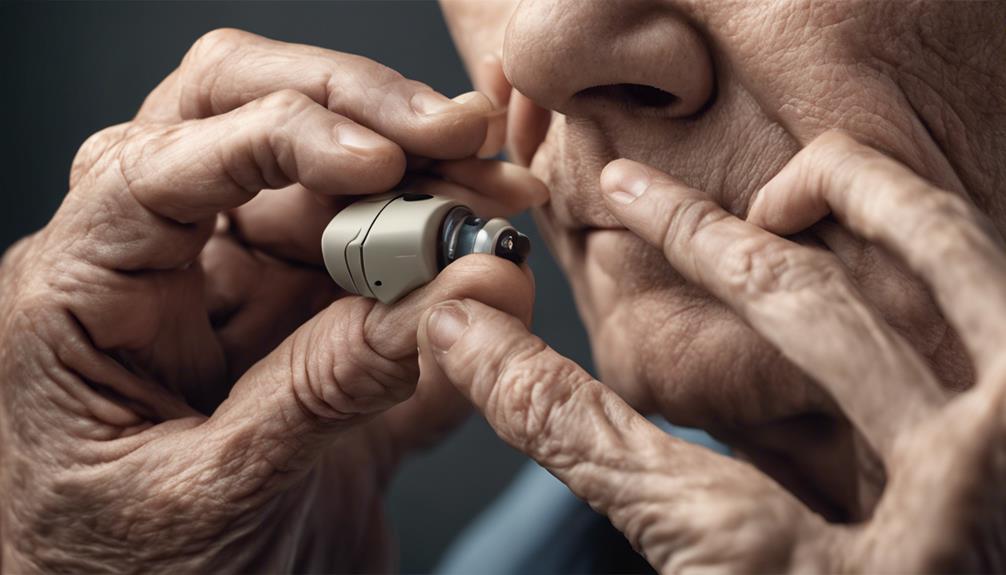Have you ever experienced the frustration of hearing aids consistently sounding tinny, despite adjustments?
Picture this: you're in a crowded room, struggling to make out conversations clearly due to that metallic tone.
But fear not, there are solutions to enhance your listening experience.
From simple cleaning techniques to exploring advanced models, we'll uncover practical tips to help you enjoy clearer, more natural sound from your hearing aids.
Stay tuned to discover how you can finally bid farewell to that tinny annoyance.
Key Takeaways
- Gradual volume adjustments help alleviate tinny sounds in hearing aids.
- Proper maintenance with gentle cleaning techniques enhances sound quality.
- Tailored acclimatization plans aid in reducing artificial sound perception.
- Consultation with an audiologist for personalized calibration resolves tinny sound issues effectively.
Common Reasons for Tinny Sounds
In our experience working with individuals who use hearing aids, we've found that one common reason for experiencing tinny sounds is sensorineural hearing loss in higher frequencies. This type of hearing loss affects the ability to hear sounds in the high-frequency range, leading to a tinny or distorted perception of audio through hearing aids.
When the brain is no longer accustomed to processing these higher frequency sounds due to prolonged hearing loss, the amplified sounds from hearing aids may initially come across as tinny or unnatural. To address this issue, gradual volume adjustment is crucial to help the brain readjust to these amplified sounds and reduce the tinny effect over time.
Tailored acclimatization plans based on individual hearing loss profiles can also play a key role in minimizing tinny sounds and ensuring a more comfortable listening experience with hearing aids.
Proper Cleaning Techniques for Hearing Aids

Let's talk about the essential aspects of properly cleaning your hearing aids.
We'll cover the cleaning tools needed, the recommended frequency of cleaning, and gentle techniques to ensure effective maintenance.
Taking care of your hearing aids through regular cleaning is crucial for optimal performance and durability.
Cleaning Tools Needed
Regular maintenance of hearing aids requires the use of specific cleaning tools to ensure optimal performance and longevity of the devices. When cleaning your hearing aids, having the right tools on hand is crucial. Here are the essential cleaning tools you'll need:
- Soft Cloth: For wiping down the surface of the hearing aid.
- Brush: To remove debris and dirt from crevices and openings.
- Wax Pick: Ideal for clearing any wax buildup in the ear canal.
- Drying Container: Helps remove moisture and prevent damage to the hearing aid components.
Frequency of Cleaning
To maintain optimal performance and prevent wax buildup in your hearing aids, it's essential to clean them daily using a soft, dry cloth and a brush to remove debris from vents.
By taking the time to adjust your routine for regular cleaning, you can ensure that your hearing aids continue to provide clear sound quality. Consistent cleaning not only prevents issues like tinny sound but also extends the lifespan of your devices.
Remember to avoid using water or cleaning solutions, as they can harm the sensitive components of your hearing aids. If you have any concerns or need specific guidance on cleaning your particular hearing aid model, don't hesitate to consult your audiologist for personalized instructions.
Regular maintenance is key to enjoying the full benefits of your hearing aids.
Gentle Cleaning Techniques
Maintaining the optimal performance of your hearing aids involves employing gentle cleaning techniques to ensure clear sound quality and prevent issues like tinny sound. Here are some essential tips for effective cleaning:
- Use a soft, dry cloth to gently wipe down the hearing aids to remove any debris or earwax buildup.
- Avoid using water, cleaning solvents, or harsh chemicals that can damage the delicate components of the hearing aids.
- Utilize a brush or a pick tool provided by your audiologist to clean hard-to-reach areas like vents and microphone openings.
- Regular cleaning helps prevent sound distortion and maintains the longevity of your hearing aids. Remember to follow the manufacturer's guidelines for cleaning to ensure optimal performance and sound quality.
Adjusting the Volume and Settings

Let's explore some key tips for adjusting the volume and settings of your hearing aids.
Starting with softer settings at higher frequencies can help reduce that tinny sound you might be experiencing.
Gradually increasing the volume to achieve the desired amplification level can greatly enhance your sound quality.
Volume Control Tips
When adjusting the volume and settings of your hearing aids, it's important to gradually find the optimal amplification level for clearer sound quality. Here are some volume control tips to help you achieve the best sound:
- Start with a softer setting at higher frequencies to prevent the tinny effect.
- Increase the volume slowly, allowing your brain to adapt to the new sounds.
- Be patient and avoid rushing to the target amplification level to avoid discomfort.
- Consistent wear of your hearing aids, especially during the adaptation period, can help in reducing the tinny or artificial sound.
Setting Adjustments Guide
To optimize the performance of your hearing aids, adjusting the volume and settings is crucial for achieving clear and natural sound quality. Begin by setting lower volumes at higher frequencies to reduce any tinny sounds.
Slowly increase the volume until you reach the desired amplification level, allowing your brain time to adapt to the new sounds without them sounding tinny. Rushing adjustments can lead to discomfort and hinder the adaptation process.
It's essential to be patient and give yourself time to acclimatize. Tailored acclimatization plans can also be beneficial for individuals with hearing loss, helping them adjust effectively to their hearing aids.
Consultation With Audiologist for Calibration

Consulting with an audiologist is crucial for fine-tuning the calibration of hearing aids to address tinny sound issues effectively. When seeking help with hearing care, here are four key reasons why consulting an audiologist for calibration is essential:
- Professional Expertise: Audiologists have the training and expertise to properly calibrate hearing aids, ensuring optimal performance.
- Personalized Adjustments: Through consultation, audiologists can make customized adjustments based on individual hearing needs and preferences.
- Tinny Sound Resolution: Audiologists can adjust high-frequency boosts to mitigate tinny sound issues and improve overall sound quality.
- Enhanced Listening Experience: Customized settings provided by an audiologist can enhance experiences, particularly when listening to music or engaging in conversations.
Understanding Frequency Response of Hearing Aids

Understanding the frequency response of hearing aids is crucial for optimizing sound quality and addressing specific hearing needs effectively. Hearing aids are designed to amplify higher frequencies more than lower ones, compensating for common sensorineural hearing loss.
However, restoring high frequencies can sometimes lead to a tinny sound as the brain adjusts to these amplified sounds. This adjustment period can impact music listening experiences negatively, especially if there's an overcompensation for high-frequency loss. Audiologists can customize hearing aid settings to adjust high-frequency boosts, improving music settings and overall hearing health.
Tailoring settings, such as increasing bass in the music program, can help mitigate the tinny sound effect in hearing aids, providing a more balanced and natural listening experience. By understanding how different frequencies are amplified and adjusting settings accordingly, individuals can better utilize their hearing aids for improved sound quality and comfort in various listening environments.
Utilizing Noise Reduction Features

Noise reduction features in hearing aids play a vital role in enhancing sound clarity by filtering out background noise. When looking to optimize the performance of your hearing aids in environments with high ambient noise levels, utilizing these features can make a significant difference in your listening experience.
Here are some key points to consider when using noise reduction features:
- Speech Understanding: Noise reduction features help in improving speech understanding, especially in situations where there's a lot of background noise present.
- Comfort in Various Environments: Advanced noise reduction technology enhances listening comfort by reducing unwanted noise, allowing you to focus on the sounds you want to hear.
- Customizable Settings: Users can adjust noise reduction settings based on their preferences and needs, ensuring a personalized experience tailored to individual requirements.
- Enhanced Listening Experience: By utilizing noise reduction features, particularly in higher frequencies, the overall listening experience with hearing aids can be significantly improved.
Importance of Regular Maintenance

Regular maintenance of your hearing aids is essential to ensure optimal performance and sound quality over time. When you wear hearing aids, it's crucial to keep them clean to prevent any buildup that could affect how well you hear.
Regularly checking the battery levels in your hearing aids is also important to maintain their performance and prevent any issues with sound quality. Ensuring that your hearing aids fit properly is key to achieving clear sound and avoiding a tinny effect. Making adjustments to the settings as needed can help address any sound quality issues you may encounter.
Additionally, seeking professional help for routine check-ups and adjustments is vital in maintaining your hearing aids' overall performance and sound quality. By staying proactive with the regular maintenance of your hearing aids, you can enjoy clearer sound and optimal performance for a longer period.
Exploring Different Hearing Aid Models

To further enhance your hearing experience and address any sound quality concerns, exploring different hearing aid models can offer a range of options tailored to individual needs and preferences. When considering different hearing aid models, it's essential to focus on the latest advancements in hearing aid technology to ensure optimal performance.
Here are some key points to keep in mind:
- Sound Quality: Different models offer varying sound quality features, with advanced options like the Widex Moment focusing on reducing artificial sounds and enhancing natural hearing experiences.
- Customizable Settings: Some models come with customizable settings that allow for adjustments to address specific issues such as tinny sound problems, providing a more personalized listening experience.
- Bass Response: Newer models with earbud-like receivers aim to improve bass response, resulting in a more balanced sound profile that may help reduce the tinny effect.
- Comfort and Performance: Exploring alternative models can lead to finding a hearing aid that not only delivers better sound quality but also ensures comfort and overall improved performance tailored to your preferences.
Lifestyle Changes for Improved Sound Quality

Making adjustments to your daily routine can play a significant role in enhancing the quality of sound you experience with your hearing aids. When it comes to improving sound quality, simple lifestyle changes can make a big difference. For instance, adjusting the high-frequency boosts in your music settings can help create a more balanced sound. Increasing bass levels in the music program can also enhance your listening experience by providing a fuller sound. Additionally, considering custom molds or exploring alternative hearing aid models may address any tinny sound issues you may be experiencing.
Moreover, tailoring settings to your personal preferences using self-programming aids is a proactive way to enhance the sound quality of your hearing aids. Working closely with audiologists for adjustments and customization can significantly improve your overall user experience. By incorporating these lifestyle changes and seeking professional guidance, you can optimize the sound quality of your hearing aids and enjoy a more fulfilling auditory experience.
Frequently Asked Questions
How Do You Get Rid of Tinny Sound in Hearing Aids?
We can address tinny sound in hearing aids by adjusting high-frequency boosts and customizing music settings for better bass. Self-programmable aids allow tailored adjustments while exploring alternative models with improved sound quality is an option.
Custom molds can also enhance sound quality and reduce tinny effects. It's essential to find the right balance for a comfortable and clear hearing experience.
Are All Hearing Aids Tinny Sounding?
Not all hearing aids sound tinny; the perception of tinny sound can vary based on individual hearing loss and device settings. Factors like high-frequency amplification and brain adaptation play a role in the tinny sound perception with hearing aids.
Customization options, adjustments, and newer hearing aid technologies can address the tinny sound issue for some users. The physical design and size of hearing aid receivers can influence the sound quality, potentially leading to a tinny effect.
How Can I Make My Hearing Aid Sound Better?
We can enhance the sound quality of our hearing aids by adjusting high-frequency boosts or increasing bass in the music program. Custom molds and self-programming options offer personalized settings for improved listening experiences.
Exploring alternative models with earbud-like receivers may also provide better sound quality. By tailoring our settings to our preferences, we can make our hearing aids sound better and enhance our overall auditory experience.
What Are a Few Common Complaints About Hearing Aids?
We hear various complaints about hearing aids, such as discomfort, unclear sound, and difficulty adjusting settings. Users often struggle with the tinny or artificial sound due to processing delays. These challenges can impact our quality of life and communication.
It's crucial to address these concerns to ensure our hearing aids enhance our hearing experience effectively. It's essential to find solutions that meet our individual needs and preferences.
Conclusion
In conclusion, by implementing proper cleaning techniques, adjusting volume settings, and consulting with audiologists for calibration, we can overcome the tinny sounds in our hearing aids.
Understanding frequency response, utilizing noise reduction features, and regular maintenance are key for improved sound quality.
Exploring different hearing aid models and making lifestyle changes can further enhance our hearing experience.
Let's embrace these solutions to enjoy clearer, more natural sound and better communication in our daily lives.











